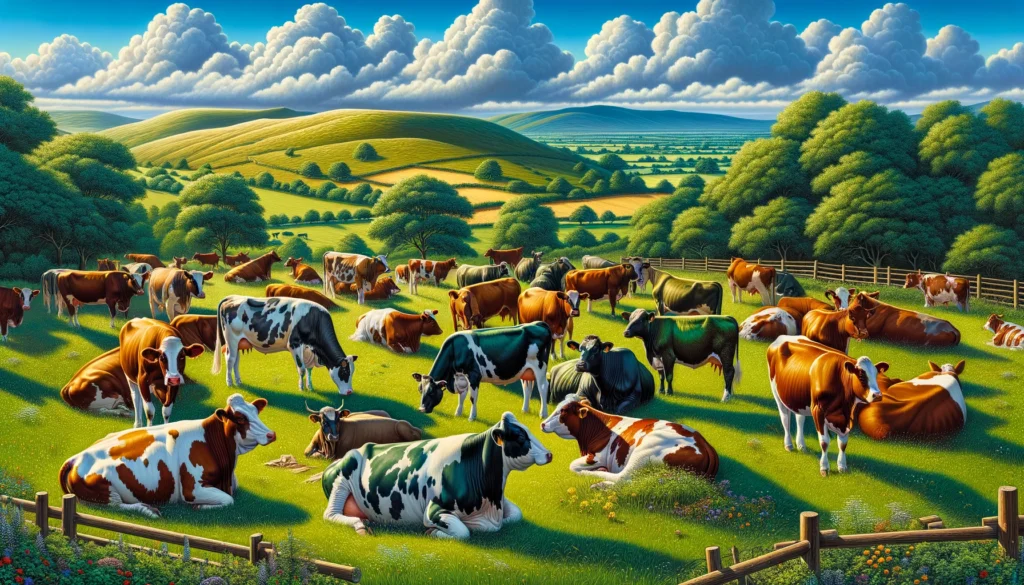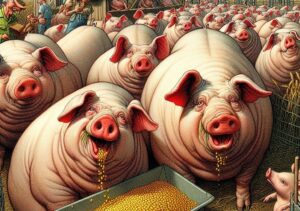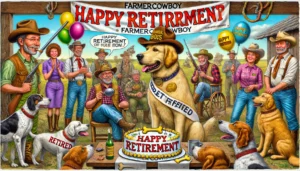
Agriculture Dictionary A vivid and detailed illustration of a cowherd in a large green pasture. The scene includes a mix of different cow breeds grazing and resting togethe2.webp.webp

Definition: Cowherd
A cowherd refers to a group of cows managed together, typically on a farm or ranch. This term can also refer to the people responsible for managing these cattle. The primary function of a cowherd is the production of beef or dairy products, depending on the specific operation.
In-Depth Analysis and Applications
- Herd Composition and Management: A cowherd consists of various cattle, including cows, bulls, heifers, steers, and calves. Effective herd management involves maintaining the health, productivity, and welfare of all these animals. This includes regular health check-ups, vaccinations, and ensuring adequate nutrition and shelter.
- Breeding Practices: Step-by-Step Guide:
- Selection: Choose high-quality breeding stock based on traits such as health, productivity, and genetics.
- Breeding Season: Plan the breeding season to optimize resource use and manage calving periods.
- Artificial Insemination (AI): Use AI for introducing superior genetics, or manage natural breeding with bulls.
- Pregnancy Checks: Regularly check cows for pregnancy to monitor and manage their health.
Pro Tips:
- Nutrition and Feeding: Insider Knowledge:
- Provide a balanced diet tailored to the specific needs of different cattle groups (e.g., lactating cows, growing calves).
- Ensure continuous access to clean water.
- Rotate pastures to prevent overgrazing and maintain pasture health.
Expert Insights:
- Collaborate with a livestock nutritionist to develop optimized feeding plans.
- Use supplements to address specific nutritional deficiencies.
- Health Management: Best Practices:
- Implement a vaccination schedule to prevent common diseases.
- Conduct regular deworming to control parasitic infections.
- Monitor for signs of illness and provide timely veterinary care.
How-to Tutorials:
- Administering Vaccinations: Step-by-step instructions on how to safely and effectively vaccinate cattle.
- Hoof Care: Regular hoof trimming and maintenance procedures.
- Weaning and Calf Management: Practical Advice:
- Wean calves at around 6-8 months, gradually transitioning them to a solid diet.
- Provide a stress-free environment during the weaning process to minimize health issues.
Comprehensive Coverage:
- Discuss various weaning methods, including fence-line weaning and abrupt weaning, and their respective benefits.
- Environmental Considerations: Sustainable Practices:
Innovative Techniques:
- Explore precision agriculture technologies to monitor pasture conditions and cattle health in real-time.
- Economic Importance: Cowherds are a significant economic asset in the agricultural industry. They provide a continuous supply of beef and dairy products, contributing to local and global food systems. Effective management of a cowherd can lead to higher productivity and profitability.
- Cultural and Societal Roles: In many cultures, cowherds are integral to rural life and traditions. They often symbolize agricultural heritage and are featured in festivals, educational programs, and rural tourism. The role of the cowherd in sustaining local economies and communities cannot be overstated.
- Challenges and Future Directions:
- Health Management: Ongoing advancements in veterinary care and disease prevention are crucial.
- Sustainability: Developing sustainable practices for cowherd management is vital for the future of cattle farming.
- Genetic Improvement: Focus on genetic selection for traits such as growth efficiency, disease resistance, and productivity.
- Market Dynamics: The economic viability of managing a cowherd depends on market conditions, including demand for beef and dairy products and the costs of feed and healthcare.
- Industry Trends:
- Precision Agriculture: The use of technology in monitoring and managing cowherds is increasing.
- Genomics: Advances in genomics are improving the selection process for breeding cowherds with desirable traits.
- Welfare Standards: Enhanced animal welfare standards and practices are becoming more prevalent, driven by consumer demand and regulatory requirements.
- Global Trade: The trade of cattle and genetic material across borders is contributing to global improvement in cowherd management.
Resources for Further Exploration:

Originally posted 2024-06-11 03:26:54.
Fall off the barn roof and busted your keister? Life on the farm or ranch can be tough on the bum. Need a break? Laugh it off at FarmerCowboy.com, the #1 farm humor site. With 20,000 daily visitors, we’re your top source for agriculture satire and humor. Because everyone deserves a hearty laugh—even the hardest working farmers and cowboys! Join us and turn those long days into fun tales at FarmerCowboy.com.
Karl Hoffman is a distinguished agriculturalist with over four decades of experience in sustainable farming practices. He holds a Ph.D. in Agronomy from Cornell University and has made significant contributions as a professor at Iowa State University. Hoffman’s groundbreaking research on integrated pest management and soil health has revolutionized modern agriculture. As a respected farm journalist, his column “Field Notes with Karl Hoffman” and his blog “The Modern Farmer” provide insightful, practical advice to a global audience. Hoffman’s work with the USDA and the United Nations FAO has enhanced food security worldwide. His awards include the USDA’s Distinguished Service Award and the World Food Prize, reflecting his profound impact on agriculture and sustainability.





